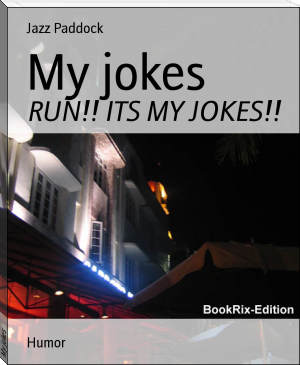A Book of Burlesques, H. L. Mencken [best e book reader .txt] 📗

- Author: H. L. Mencken
Book online «A Book of Burlesques, H. L. Mencken [best e book reader .txt] 📗». Author H. L. Mencken

[44]Again silence. Then a single piccolo plays the closing cadence of the composition:

Ruhm und Ewigkeit presents enormous difficulties to the performers, and taxes the generalship of the most skillful conductor. When it was in preparation at the Gewandhaus the first performance was postponed twelve times in order to extend the rehearsals. It was reported in the German papers at the time that ten members of the orchestra, including the first flutist, Ewald Löwenhals, resigned during the rehearsals, and that the intervention of the King of Saxony was necessary to make them reconsider their resignations. One of the second violins, Hugo Zehndaumen, resorted to stimulants in anticipation of the opening performance, and while on his way to the hall was run over by a taxicab. The conductor was Nikisch. A performance at Munich followed, and on May 1, 1913, the work reached Berlin. At the public rehearsal there was a riot led by members of the Bach Gesellschaft, and the hall was stormed by the mounted police. Many arrests [45]were made, and five of the rioters were taken to hospital with serious injuries. The work was put into rehearsal by the Boston Symphony Orchestra in 1914. The rehearsals have been proceeding ever since. A piano transcription for sixteen hands has been published.
Kraus was born at Hamburg on January 14, 1872. At the age of three he performed creditably on the zither, cornet and trombone, and by 1877 he had already appeared in concert at Danzig. His family was very poor, and his early years were full of difficulties. It is said that, at the age of nine, he copied the whole score of Wagner’s Ring, the scores of the nine Beethoven symphonies and the complete works of Mozart. His regular teacher, in those days, was Stadtpfeifer Schmidt, who instructed him in piano and thorough-bass. In 1884, desiring to have lessons in counterpoint from Prof. Kalbsbraten, of Mainz, he walked to that city from Hamburg once a week—a distance for the round trip of 316 miles. In 1887 he went to Berlin and became fourth cornetist of the Philharmonic Orchestra and valet to Dr. Schweinsrippen, the conductor. In Berlin he studied violin and second violin under the Polish virtuoso, Pbyschbrweski, and also had [46]lessons in composition from Wilhelm Geigenheimer, formerly third triangle and assistant librarian at Bayreuth.
His first composition, a march for cornet, violin and piano, was performed on July 18, 1888, at the annual ball of the Arbeiter Liedertafel in Berlin. It attracted little attention, but six months later the young composer made musical Berlin talk about him by producing a composition called Adenoids, for twelve tenors, a cappella, to words by Otto Julius Bierbaum. This was first heard at an open air concert given in the Tiergarten by the Sozialist Liederkranz. It was soon after repeated by the choir of the Gottesgelehrheitsakademie, and Kraus found himself a famous young man. His string quartet in G sharp minor, first played early in 1889 by the quartet led by Prof. Rudolph Wurst, added to his growing celebrity, and when his first tone poem for orchestra, Fuchs, Du Hast die Gans Gestohlen, was done by the Philharmonic in the autumn of 1889, under Dr. Lachschinken, it was hailed with acclaim.
Kraus has since written twelve symphonies (two choral), nine tone-poems, a suite for brass and tympani, a trio for harp, tuba and glockenspiel, ten string quartettes, a serenade for flute [47]and contra-bassoon, four concert overtures, a cornet concerto, and many songs and piano pieces. His best-known work, perhaps, is his symphony in F flat major, in eight movements. But Kraus himself is said to regard this huge work as trivial. His own favorite, according to his biographer, Dr. Linsensuppe, is Ruhm und Ewigkeit, though he is also fond of the tone-poem which immediately preceded it, Rinderbrust und Meerrettig. He has written a choral for sixty trombones, dedicated to Field Marshal von Hindenburg, and is said to be at work on a military mass for four orchestras, seven brass bands and ten choirs, with the usual soloists and clergy. Among his principal works are Der Ewigen Wiederkunft (a ten part fugue for full orchestra), Biergemütlichkeit, his Oberkellner and Uebermensch concert overtures, and his setting (for mixed chorus) of the old German hymn:
Saufst net—stirbst a!
Also, saufst!
Kraus is now a resident of Munich, where he conducts the orchestra at the Löwenbräuhaus. He has been married eight times and is at present the fifth husband of Tilly Heintz, [48]the opera singer. He has been decorated by the Kaiser, by the King of Sweden and by the Sultan of Turkey, and is a member of the German Odd Fellows.
[49]
III.—THE WEDDINGIII.—The Wedding. A Stage Direction
[51]The scene is a church in an American city of about half a million population, and the time is about eleven o’clock of a fine morning in early spring. The neighborhood is well-to-do, but not quite fashionable. That is to say, most of the families of the vicinage keep two servants (alas, more or less intermittently!), and eat dinner at half-past six, and about one in every four boasts a colored butler (who attends to the fires, washes windows and helps with the sweeping), and a last year’s automobile. The heads of these families are merchandise brokers; jobbers in notions, hardware and drugs; manufacturers of candy, hats, badges, office furniture, blank books, picture frames, wire goods and patent medicines; managers of steamboat lines; district agents of insurance companies; owners of commercial printing offices, and other such business men of substance—and the prosperous lawyers and popular family doctors who [52]keep them out of trouble. In one block live a Congressman and two college professors, one of whom has written an unimportant textbook and got himself into “Who’s Who in America.” In the block above lives a man who once ran for Mayor of the city, and came near being elected.
The wives of these householders wear good clothes and have a liking for a reasonable gayety, but very few of them can pretend to what is vaguely called social standing, and, to do them justice, not many of them waste any time lamenting it. They have, taking one with another, about three children apiece, and are good mothers. A few of them belong to women’s clubs or flirt with the suffragettes, but the majority can get all of the intellectual stimulation they crave in the Ladies’ Home Journal and the Saturday Evening Post, with Vogue added for its fashions. Most of them, deep down in their hearts, suspect their husbands of secret frivolity, and about ten per cent. have the proofs, but it is rare for them to make rows about it, and the divorce rate among them is thus very low. Themselves indifferent cooks, they are unable to teach their servants the art, and so the food they set before their husbands and children is often such as would make a Frenchman cut [53]his throat. But they are diligent housewives otherwise; they see to it that the windows are washed, that no one tracks mud into the hall, that the servants do not waste coal, sugar, soap and gas, and that the family buttons are always sewed on. In religion these estimable wives are pious in habit but somewhat nebulous in faith. That is to say, they regard any person who specifically refuses to go to church as a heathen, but they themselves are by no means regular in attendance, and not one in ten of them could tell you whether transubstantiation is a Roman Catholic or a Dunkard doctrine. About two per cent. have dallied more or less gingerly with Christian Science, their average period of belief being one year.
The church we are in is like the neighborhood and its people: well-to-do but not fashionable. It is Protestant in faith and probably Episcopalian. The pews are of thick, yellow-brown oak, severe in pattern and hideous in color. In each there is a long, removable cushion of a dark, purplish, dirty hue, with here and there some of its hair stuffing showing. The stained-glass windows, which were all bought ready-made and depict scenes from the New Testament, commemorate the virtues of departed worthies of the neighborhood, whose [54]names appear, in illegible black letters, in the lower panels. The floor is covered with a carpet of some tough, fibrous material, apparently a sort of grass, and along the center aisle it is much worn. The normal smell of the place is rather less unpleasant than that of most other halls, for on the one day when it is regularly crowded practically all of the persons gathered together have been very recently bathed.
On this fine morning, however, it is full of heavy, mortuary perfumes, for a couple of florist’s men have just finished decorating the chancel with flowers and potted palms. Just behind the chancel rail, facing the center aisle, there is a prie-dieu, and to either side of it are great banks of lilies, carnations, gardenias and roses. Three or four feet behind the prie-dieu and completely concealing the high altar, there is a dense jungle of palms. Those in the front rank are authentically growing in pots, but behind them the florist’s men have artfully placed some more durable, and hence more profitable, sophistications. Anon the rev. clergyman, emerging from the vestry-room to the right, will pass along the front of this jungle to the prie-dieu, and so, framed in flowers, face the congregation with his saponaceous smile.
The florist’s men, having completed their labors, [55]are preparing to depart. The older of the two, a man in the fifties, shows the ease of an experienced hand by taking out a large plug of tobacco and gnawing off a substantial chew. The desire to spit seizing him shortly, he proceeds to gratify it by a trick long practised by gasfitters, musicians, caterer’s helpers, piano movers and other such alien invaders of the domestic hearth. That is to say, he hunts for a place where the carpet is loose along the chancel rail, finds it where two lengths join, deftly turns up a flap, spits upon the bare floor, and then lets the flap fall back, finally giving it a pat with the sole of his foot. This done, he and his assistant leave the church to the sexton, who has been sweeping the vestibule, and, after passing the time of day with the two men who are putting up a striped awning from the door to the curb, disappear into a nearby speak-easy, there to wait and refresh themselves until the wedding is over, and it is time to take away their lilies, their carnations and their synthetic palms.
It is now a quarter past eleven, and two flappers of the neighborhood, giggling and arm-in-arm, approach the sexton and inquire of him if they may enter. He asks them if they have tickets and when they say they haven’t, he tells [56]them that he ain’t got no right to let them in, and don’t know nothing about what the rule is going to be. At some weddings, he goes on, hardly nobody ain’t allowed in, but then again, sometimes they don’t scarcely look at the tickets at all. The two flappers retire abashed, and as the sexton finishes his sweeping, there enters the organist.
The organist is a tall, thin man of melancholy, uræmic aspect, wearing a black slouch hat with a wide brim and a yellow overcoat that barely reaches to his knees. A pupil, in his youth, of a man who had once studied (irregularly and briefly) with Charles-Marie Widor, he acquired thereby the artistic temperament, and with it a vast fondness for malt liquor. His mood this morning is acidulous and depressed, for he spent yesterday evening in a Pilsner ausschank with two former members of the Boston Symphony Orchestra, and it was 3 A. M. before they finally agreed that Johann Sebastian Bach, all things considered, was a greater man than Beethoven, and so parted amicably. Sourness is the precise sensation that wells within him. He feels vinegary; his blood runs cold; he wishes he could immerse himself in bicarbonate of soda. But the call of his art is more potent than the protest of [57]his poisoned and quaking liver, and so he manfully climbs the spiral stairway to his organ-loft.
Once there, he takes off his hat and overcoat, stoops down to blow the dust off the organ keys, throws the electrical switch which sets the





Comments (0)